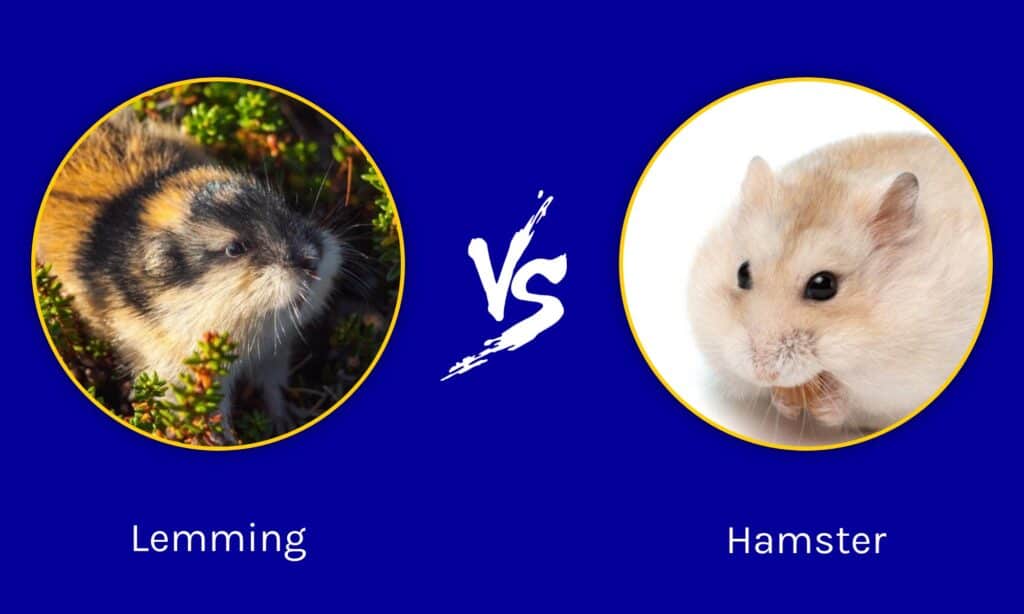Lemmings and hamsters are extremely similar rodents that are both popular, albeit for different reasons. Hamsters are some of the most popular pets, while lemmings have earned a name for themselves as the “suicidal rodents,” although this behavior is quite the misconception. Despite their similarities, these rodents are distinct and unique. Today, we will explore the difference between them and learn a bit about their lives. Let’s discover: Lemming vs Hamster; what makes them special?
Comparing a Lemming and a Hamster

| Lemming | Hamster | |
|---|---|---|
| Appearance | 3-6 inches long and usually less than 4 ounces. Round in shape with brown and black fur. Rodent-like. | 19 species, but always small and rodent-like. Soft fur can be black, grey, honey, white, brown, yellow, red, or a mix, depending on the species. |
| Distribution | North American and Eurasia. | Syria, Greece, Romania, Belgium, and northern China. |
| Habitat | Arctic and tundra biomes, including alpine regions, coniferous forests, and sphagnum bogs. | Live underground. Prefer dry areas, including steppes, sand dunes, and the edges of deserts. |
| Interesting behaviors | Mistakenly believed to throw themselves from cliffs. Don’t hide from predators, but instead try to fight them. | Crepuscular. Have poor eyesight and are considered nearsighted and colorblind. Carry food in their cheeks. |
| Human relationship | They aren’t kept by humans, but misconceptions about them have been around for hundreds of years. | Often kept as pets. Used in scientific research as a lab animal. |
The 5 main differences between a Lemming and a Hamster
The main differences between a lemming and a hamster are where they live, their appearance, and their relationship with humans.
Lemmings and hamsters are both rodents that belong to the superfamily Muroidea, which includes rats, mice, and gerbils. As such, lemmings and hamsters are closely related despite living in different places in the world.
Both lemmings and hamsters are widely known, although for different reasons. Lemmings have had many misconceptions surrounding them since the 16th century. When they were first discovered, scientists believed they fell from the sky and died in the grass. Hamsters are also well-known, albeit for a less exciting reason. Hamsters are popular pets and have become extremely prevalent all over the world. Additionally, they are used in many lab environments as test animals.
One of the main differences between the two is that lemmings are arctic rodents that can be found in the polar regions of North America and Eurasia. These cold-dwelling animals are herbivorous and spend their time foraging for grass and seeds. Hamsters are found in Eurasia, but only in the warm regions around steppes and deserts. Additionally, hamsters are omnivorous and can eat insects, fruits, grasses, and even meat.
Let’s explore these differences, plus a few more, below.
Lemming vs Hamster: Appearance

Lemmings are rounder and come in brown, black, and white, while hamsters are much more variable in color.
©Angelica Klingberg/Shutterstock.com
Lemmings and hamsters are both small rodents, roughly 3-6 inches at their minimum and maximum. Still, lemmings look a little different from hamsters. They are generally rounder animals and have much longer fur, an adaptation to their cold environment. Lemmings come in shades of brown and black fur.
Hamsters are also small rodents, although they aren’t generally as round as a lemming is. Additionally, their fur is short, an adaption to the hot environments they generally live in. Hamsters come in a larger variety of colors, some of which have been artificially selected by humans. These fur colors include black, grey, honey, white, brown, yellow, red, or a mix of any of them.
Lemming vs Hamster: Distribution

Hamsters are widely distributed.
©Adrin Shamsudin/Shutterstock.com
Hamsters are widely distributed, just in different places than lemmings. They can be found in Syria, Greece, Romania, Belgium, and northern China wild. They have also been introduced in other places as pets.
There are a few species of lemming, but all of them can generally be found in the polar regions of North America and Eurasia. They are present in the United States, Canada, Greenland, Scandinavia, Russia, and China.
Lemming vs Hamster: Habitat

The lemming prefers arctic habitats, while hamsters prefer warmer, dryer regions.
©AnnaSmirnova/Shutterstock.com
Lemmings can be found in the far northern regions of the world. They prefer regions with arctic and tundra biomes, including alpine regions, coniferous forests, and sphagnum bogs. Snow doesn’t bother these rodents as they burrow under it during the winter.
Hamsters prefer the opposite type of habitat from lemmings. They generally prefer warmer, dryer regions within their distribution. Hamsters can be found in steppes, sand dunes, and on the edges of deserts, plus anywhere humans are keeping them as pets.
Lemming vs Hamster: Interesting behavior

Lemmings don’t throw themselves from cliffs, contrary to popular belief.
The lemming is one of the most curious rodents around, especially knowing just how wrong humans have historically been with their behaviors. Contrary to popular belief, they don’t commit “mass suicide” and run off of cliffs each year. Instead, they experience large population swings that are generally tempered by the predators in the area, notably birds of prey and stoats. Additionally, they aren’t the type of rodent that runs and hides from predators; instead, preferring to fight.
Hamsters don’t have the misconceptions surrounding them that lemmings do. Still, some of their interesting behaviors include carrying massive amounts of food in their cheeks, often expanding them up to three times their original size. Additionally, hamsters are crepuscular, meaning they are most active during the evening and morning hours.
Lemming vs Hamster: Human relationship

Hamsters are some of the most popular pets around the world.
©polya_olya/Shutterstock.com
Hamsters have become some of the most popular pet rodents in the entire world. Additionally, they have become a popular lab animal and are used for research and testing globally. Almost any pet store is likely to have hamsters for sale and in a variety of colors.
There isn’t much of a relationship between lemmings and humans, at least not on the scale that we have with hamsters. Besides continuously misunderstanding lemming behavior, humans don’t interact with these rodents all that much.
The photo featured at the top of this post is © AnnaSmirnova/Shutterstock.com
Thank you for reading! Have some feedback for us? Contact the AZ Animals editorial team.






